In January of this year, while walking in St. Marys, Georgia, we heard a drone and went to check it out. What really caught our interest here was that the person with the controls wasn’t even looking at the drone. It was a DJI Mavic Pro that had some really impressive features, including the ability to fold up into a small, portable package and a mode where you could set the drone to follow a certain object or person.
We’ve wanted aerial shots for a long time. And back in 2013 Daniel Buchmueller and Fabian Hensel visited us in Hawaii. They were in town working on a remote-control drone they had built to do image acquisition for geospatial applications. They did a few test flights over Dirona and nearby Ala Moana park and took some striking photographs of the boat and the Waikiki skyline. Daniel and Fabian went on to become part of the Amazon Prime Air team, while we personally achieved less success with drones. Shortly after their visit, we bought a DJI Phantom II, but it was far from a point-and-shoot camera platform. We found it quite challenging to fly.
Seeing the Mavic Pro hovering far above us in St. Marys with the operator not even paying attention to it looked like exactly the platform we were after. We ordered one immediately. But they were back-ordered, so we didn’t actually receive it until a few weeks ago. We’ve been busy with other projects, and finally got a chance to test-fly the drone over the last couple of days. We were quite impressed. The Mavic Pro is remarkably easy to fly, and takes surprisingly good pictures.
We started out in the parking lot behind the marina with a few test take-offs and landings. Winds were a bit below 10 knots, with gusts up to 12-15, and hardly impacted the drone.
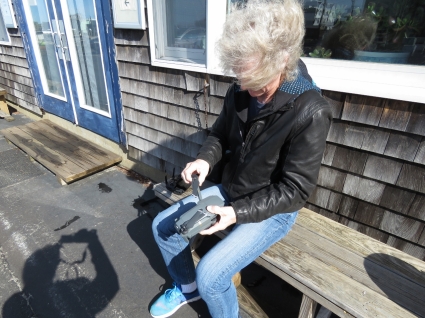
|
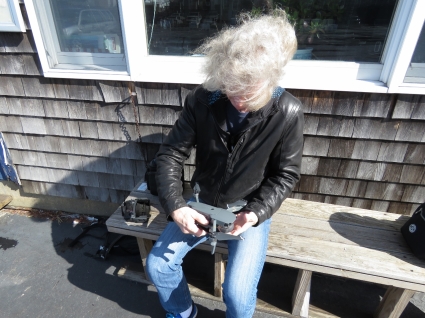
|
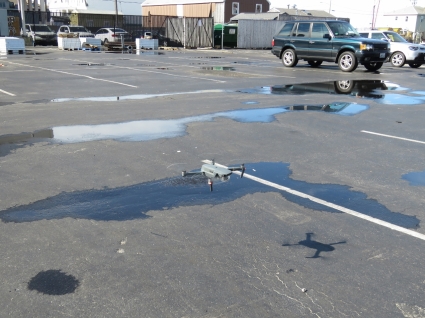
|
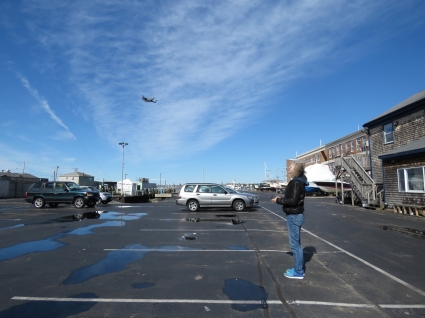
|
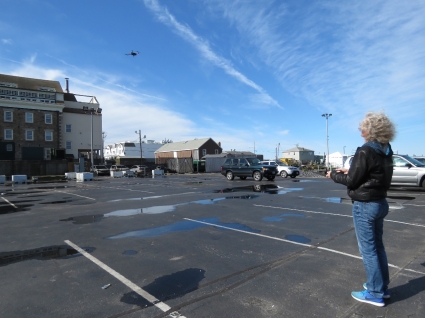
|
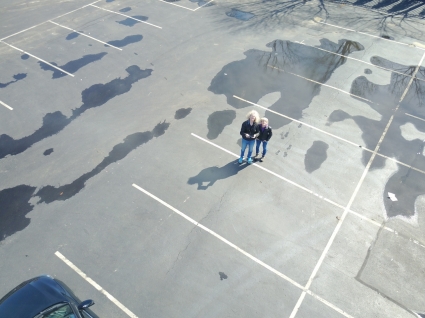
|
We quickly were comfortable enough to try some limited over-the-water flying around the marina wharf, along with a roof-deck landing.
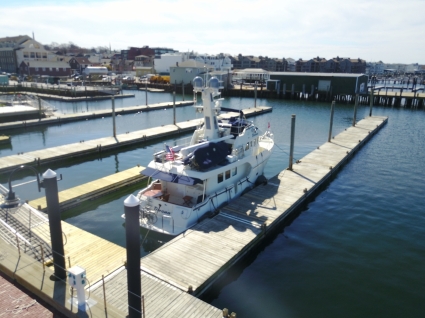
|
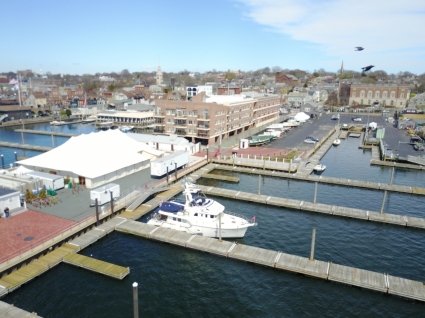
|
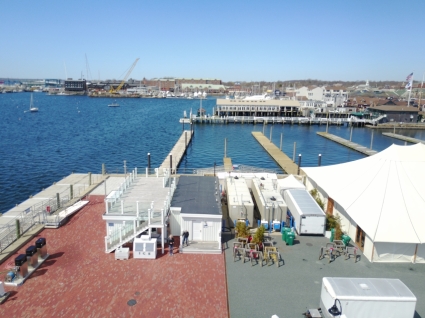
|
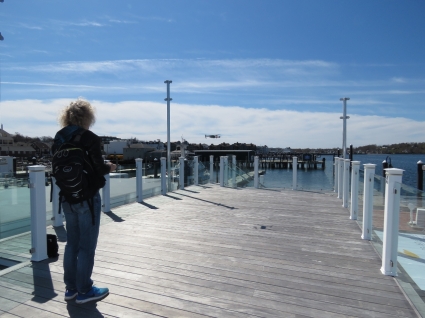
|
The following morning, we took it out for another test flight, this time taking it further over the water and away from us, while we stayed in the parking lot.
The video below is from a vantage point 50 to 100 feet over Bannister’s Wharf and the downtown area of Newport, with some aerial shots of Dirona at Newport Yachting Center. If you look closely, you’ll see the drone was occasionally under attack by a few birds apparently not encouraging a new “bird” to join the neighborhood. The Newport marinas are just getting ready for the summer season, but still aren’t formally open yet. It’s fun being the only boat in a downtown Newport marina.
The first picture below is of our lightly-used DJI Phantom II. In the second picture is our DJI Mavic Pro, which already has flown ten times further than the Phantom ever did. Another exciting aspect of the Mavic Pro is that it folds up to a compact package about the size of a small lunch bag.
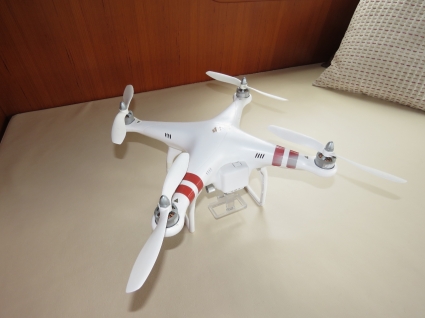
|
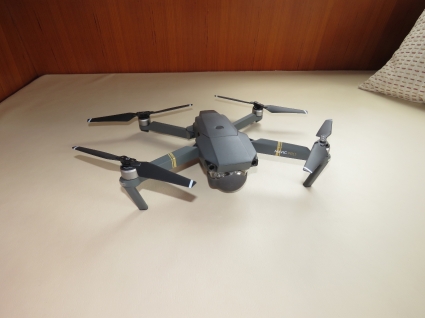
|
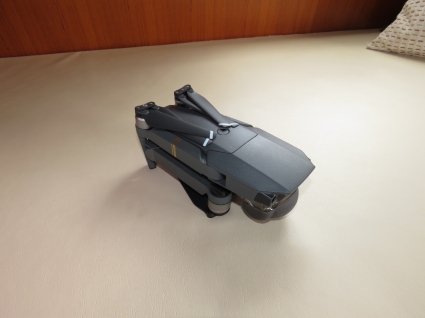
|
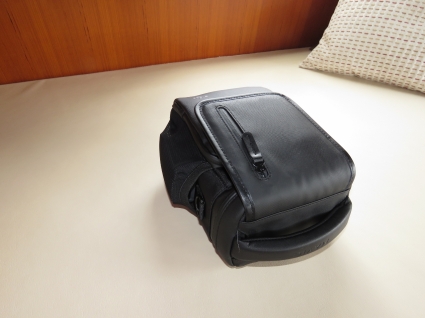
|

I am following Sam’s and your lead. Just got a Phantom 4 to take with me to Glacier Bay and Lituya Bay this year. Weather permitting i should be able to make great pictures. Learning how to fly here in Seattle before leaving. Hope I will not crash.
Hey Marc, great hearing from you. I had a Phantom II back in 2012 which I found very challenging to fly. Current DJI technology in the Mavic Pro and the Phantom 4 is amazing. I was super nervous expecting to have to be an actual pilot simultaneously aware of wind conditions, obstructions, yaw, pitch, roll, and still have a bit left for the camera. The new aircraft are incredibly stable and simple to operate. I was planning to spend a week really learning the thing — essentially treating it like work needed to be invested in return to get some interesting pictures. Not the case at all. We were flying over water on the second flight. I’m still nervous landing in tight places but these systems are super stable when everything is operating as it should. I expect a sensor failure could still fairly quickly lead to splashed aircraft.
You’ll love your Phantom 4 and will get used to it quickly. I wish we had one when we were in Alaska.
I will share with you some of the drone pictures I will make this summer. Lituya Bay should be a spectacular place for making drone pictures. Wishing you a safe Atlantic crossing.
Hiya Mark! We got underway at 4:00am this morning out of Newport and, if the weather isn’t bad, expect to be in Ireland in 19 days.
Have fun on your trip to Alaska.
James – if you want to start thinking about drone flying when you get to our side of the pond here are some tips:
* Rules in the UK: https://www.caa.co.uk/Consumers/Model-aircraft-and-drones/Flying-drones/
* Rules in Ireland: https://www.iaa.ie/general-aviation/drones
* Insurance = if your current public liability insurance for the drone won’t cover you over here there is a very affordable solution (which is what I use):- https://www.bmfa.org/Insurance/Insurance-FAQs
I always hand launch and catch when flying from the boat. I use prop guards to try and protect myself – easy on my Phantom III but I don’t know if they are available for the Mavic.
Looking forward to seeing your footage of Dirona along the Irish coast!
Michael, thanks very much for the useful links. Much appreciated.
The Phantoms have a fairly large base that allows hand capture whereas the Mavic only has the airplane body a few inches below the props to grab. The upside of the Mavic is it’s portable and folds small enough that it’s easy to transport. The downside is there isn’t much to grab. Prop guards are available for it but, to grab the body when flying, you would need to reach up from below, inside the prop guards, and the body is only a couple of inches below the plane of the props. So far landing on the boat deck seems tight but workable. When we were testing, winds were around 8 with gusts to 15 and the plane did move around a bit but it seemed workable.
Thanks again for the data above.
Yay, I’m excited to see your drone photos! I bought one before last summer’s Inside Passage trip and had a blast. Lots of neat photos pretty cool for reconnoitering unfamiliar and uncharted anchorages, too.
We put together this video and article highlighting some tips we’ve learned flying drones from boats and perhaps it will be helpful to you!
http://slowboat.com/2017/02/flying-drones-from-boats/
Great video Sam. We watched it a week or so back and really enjoyed it.
So far, the Mavic Pro seems super stable and doesn’t seem to require a ton of skill to fly. What we haven’t done yet is figured out is small space, moving vehicle take-off and landings. I suspect we’ll have to adopt your technique of just grabbing it out of the air. We’re still somewhat nervous about human error around fast moving propeller blades.
Thanks! Yeah, hand launching and retrieving seems to be the best way to avoid clipping a prop on the deck or some deck hardware. But it’s MUCH easier on the Phantom series with their big landing gear than it is on the Mavic or Inspire.
Yes, I’m nervous about grabbing the Mavic out of the air since one of us would need to be close to the props but, on the other hand, there aren’t many large surfaces to land on Dirona and, those that are appealing are surrounded by prop eating rails. The table up on the boat deck is one possibility and the other is the forward deck. Likely the biggest danger is thinking the boat is still when, in fact, it’s drifting at a knot or so. Even at a 1/2 knot, those rails will approach the drone quickly.
Sam, we’ve since landed the Mavic a couple of times on the table we have up on the boat deck. It’s actually not that difficult but there isn’t much room for error with the crane only a couple of feet away on one side, the rails a couple of feet away on the other, and the stack in front. But after three landings it seems reasonably safe as long as the boat isn’t moving.
Take a look at youtube videos on landing procedures for JSF-b variants or Harriers. The Marines use a very particular approach method that I think would apply for landing on your back deck. Essentially come along side the boat parallel to your landing zone, once perpendicular to your LZ, move at 90 degrees until over your desired location then lower yourself down. Keeps your perspective and movements to one axis at a time.
Great suggestion Eric to watch the Harrier landings for a tip on how to drop down on a moving and very small deck. What I was doing is dropping down behind the boat, moving forward dropping down some more, then slide forward and down. The harriers take a similar approach but come from the side. I’ll try both. Thanks,
Hi James,
Long time subscriber, first time poster :) Drones are great fun! We have a 4788 Bayliner. We went out to fly the drone and get some shots. I had my wife at the helm and told her to stop the boat. I powered on my drone (Phantom 4) and selected “auto take off” (goes up 4′ then gives you control”. Well…as soon as I pressed auto take off then of course confirmed it lol…I realized the boat wasn’t “stopped” but out of gear! MY mistake. The drone got up to 4′ and gave me power but I didn’t have time to get it away from the windshields on the boat….It hit the 2nd furthest windshield to port and proceeded to “walk” across the other 4 windshields then hit the hand railing and fall on the walkway! Thank goodness for that…it was quite a first flight let me tell you :) So, make sure Dirona is stopped when you take off via the boat. I want to get good enough flying where someone else could take the helm is choppy seas and I can get some good footage but that seems eons away after flight #1 over water (several successful land flights).
By the way I believe we are at the Yachts Miami show at the same time. I was hoping say hi and chat. Quite the show for yacht lovers!
Safe travels to you both on the way across the Atlantic!
Thanks for continuing the blog and the pictures…I enjoy following you guys all over the world and living vicariously through you :)
All the best,
Derek
That’s a great story Derek and a good reminder than when a boat seems stopped, it may still be moving. Important to keep in mind when docking and vital when flying off a boat. I’ve been flying out over the water but so far haven’t had the courage to fly off a boat. Even the best take off and landing locations on Dirona just look way small with lots of nearby obstacles. I know that some people snatch the drone out of the air but 4 props all moving require care especially in a moving boat. We’re still thinking through options on that one.
James, if we still had Eden I think our takeoff/landing spot would be the foredeck hatch covers. I’ve had no problem manually landing my Mavic on picnic tables that are smaller than the deck box, and the foredeck has the least amount of vertically projecting “stuff” that could interfere with your approach. In addition, if you want to do underway launch and recovery, the helm operator would have fairly clear sightlines and good communication with the pilot in case any emergency velocity changes were called for. :)
Hiya Adam. Your argument for the foredeck is a good one. Especially better communication with the helm when underway. If I did do an underway landing, I still might prefer to come up behind the boat and land on the boat deck table. However, that’s my vast experience of about 5 flights speaking :-).
I’m blown away at how well engineered the Mavic is. It’s impressively easy to fly.